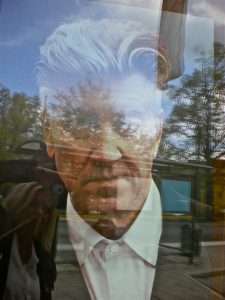
David Lynch’s 2001 masterpiece Mulholland Drive has just been re-released on 35mm, which is apparently how he always intended it. I wasn’t sure whether I would be able to tell the difference, but it was a good excuse to revisit it, so I went on Saturday night. As it happens, this format only seemed to make it appear more dated. This did not matter, however; even though this was at least the fifth time I’ve seen it, it remained as compelling as ever.
The film has been deemed cryptic and hard to understand. When it first came out, the Guardian sent six film critics to watch it, asking them to say what the plot was. They all said something different. Despite this, in a poll of film critics in 2016, it was voted the best film of the millennium. I don’t know if you had to claim to understand it in order to think this, but I admire their judgment.
Why is it so hard to understand? Clearly because Lynch wants it to be difficult, to be a challenge. It is in the tradition of various esoteric texts which are deliberately obscure in order to make the reader, or in this case the viewer, wake up from their slumbering, unconscious state.
It is a lesson in spiritual cosmology, telling the story from the point of view of four different levels: the unconscious mind (personal and collective), hidden organising principles outside space-time, the material world, and God. The film addresses the issues of incarnation, possibly karma, the nature of the unconscious mind (Freud and Jung), and has many references to ancient spiritual traditions including Plato, Kabbalah, and the ancient Mysteries.

The main ingredient of the plot is a woman (adopted name Rita, but Camilla in the material world) suffering from amnesia following a car crash, trying to remember who she is, being helped by another woman (Betty, real name Diane) whom she has met by chance. This amnesia is an allegory of the process of an incarnating soul, which forgets during the process of birth its previous lives, any karma it may have accumulated, and the preconceived plan for the present existence. (It’s interesting that Lynch compares birth into this world to a car crash!) The film then depicts the process of her gradually waking up to all these factors, and accepting her (unpleasant) fate.
The film tells the story in images and seemingly unrelated scenes – Lynch is also a painter. That is one reason why it is difficult; there are no words or conventional plot to help the viewer understand. The story, as it takes place in the material world, only begins about three-quarters of the way through, Rita having been sucked into a black hole which transports her from Diane’s unconscious psyche into the material world, and Diane having been instructed to wake up by a creepy cowboy figure (a modern American version of Hermes, the messenger of the gods). This led one of the six critics mentioned at the beginning to say that everything up that point had been a dream. This is inaccurate, because it was really the totality of the unconscious mind being depicted; dreams were only part of the story.
Everything in the film up to that point has been more or less incomprehensible, because the viewers didn’t know this at the time, thinking they were watching events in the material world, although most of these had a suspiciously unreal feel to them. It all has then to be reinterpreted once that revelation has been made, provided of course that you can remember everything you have seen, even though you didn’t understand it at the time. This is an almost impossible task, and it therefore makes sense to watch the film more than once, in order to reinterpret all this material. In the light of this knowledge, some of the earlier scenes are revealed as dreams, fantasies, wish fulfilments, unresolved negative parental complexes, and compensations for conscious attitudes (thus basic elements of Freudian and Jungian psychology). We also make the astonishing discovery that the two women, who appear to be separate beings in the material world, are interconnected at a deeper level, that in some sense they are the same person, both seeming to emanate from the same spiritual source.

There is also a film within the film – Diane is an aspiring actress who wants a part in a film that is being made. In this spiritual allegory, the director represents the conscious ego, which thinks that it is in control of its life, but gets very, very upset when it discovers that it is in fact being controlled by forces beyond the material world, which, from a traditional spiritual perspective, you might call the higher self, organising principles, or the Laws of Karma. In Mulholland Drive, however, these are presented as malevolent, demonic entities.
I’ve made a big fuss about how hard the film is to understand. It has to be said, however, that it is heavily influenced by Plato’s allegory of the cave, which is similar to the Eastern concept of maya, the illusion of taking the material world to be reality. Mulholland Drive invites us to wake up from that dream. If we had watched the earlier parts of the film from a spiritual perspective, everything would have been clear from the outset.
====================================================================================================================
(I was so excited by the film when I first saw it that I wrote a song about it. You can find it on youtube, click here.)
